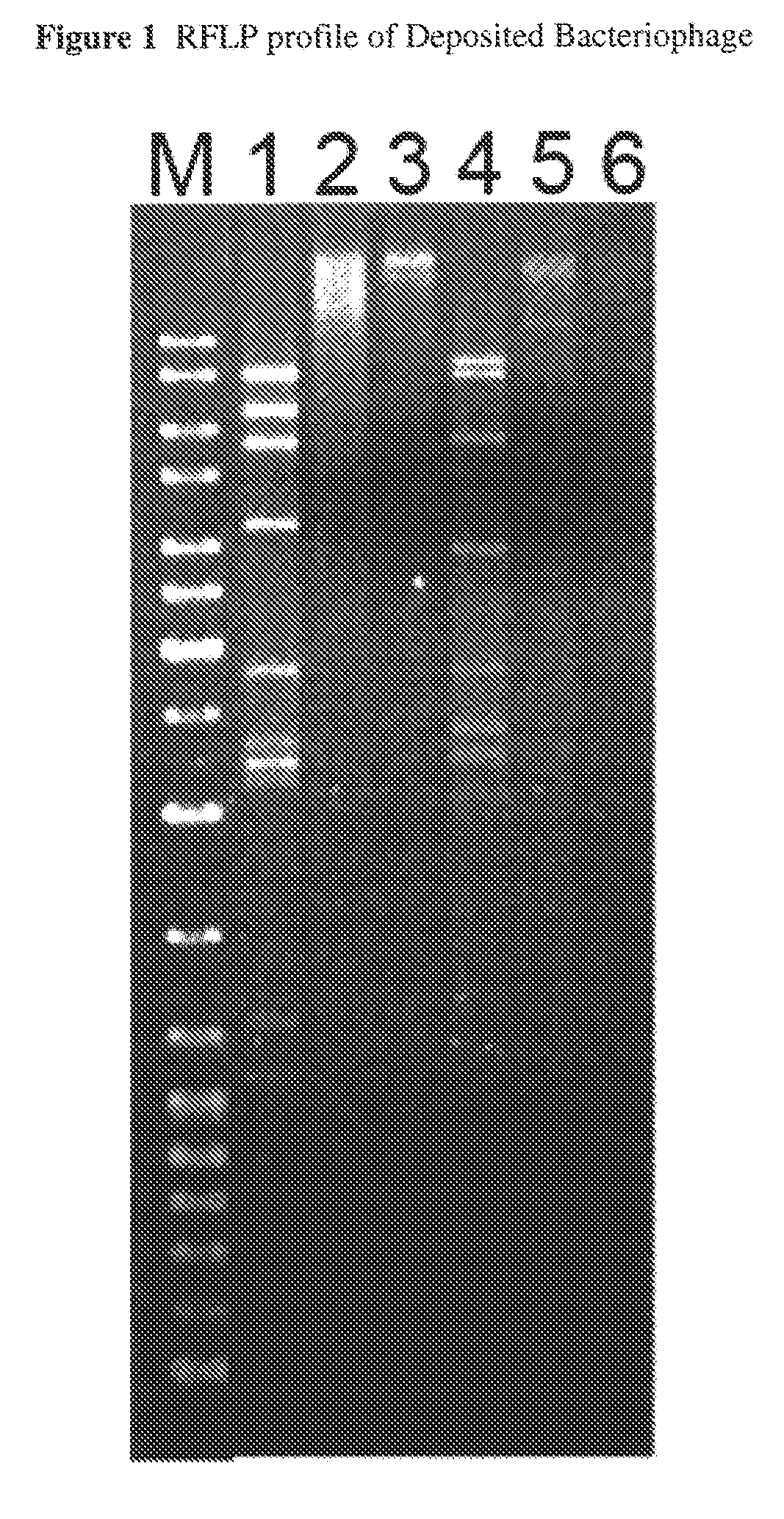Clostridium perfringens bacteriophage and uses thereof
a bacteriophage and clostridium perfringens technology, applied in the field of new bacteriophages, can solve the problems of inability to fully understand the biology of phages, inability to prevent and gradual fall out of favor in the united states and western world, so as to prevent, eradicate, or reduce the level of colonization of various animals
- Summary
- Abstract
- Description
- Claims
- Application Information
AI Technical Summary
Benefits of technology
Problems solved by technology
Method used
Image
Examples
example 1
CPAS-16 and CPLV-42 Bacteriophage Isolation
[0059]The CPAS-16 and CPLV-42 bacteriophages were isolated from environmental water sources from obtained from agricultural settings or processing plants associated with livestock and / or poultry using lysis of distinct strains the Targeted Bacteria to form plaques in bacterial lawns as a means of detecting the presence of bacteriophage having lytic specificity for the Targeted Bacteria. Plaques were harvested, diluted, and re-plated on bacterial lawns through a process of serial enrichment until a single bacteriophage species, or monophage, was obtained as determined by a stable restriction fragment length profile of the bacteriophage DNA. All incubations were performed under anaerobic conditions. The isolates obtained using the technique recited supra may be cultured using the techniques as set forth herein. The bacteriophage was deposited with the ATCC.
example 2
Deposited Bacteriophage Concentration
[0060]Concentration of the Deposited bacteriophage may be determined using techniques known in the art (Adams, M. H. (1959). Methods of study bacterial viruses. Bacteriophages. London, Interscience Publishers, Ltd.: 443-519.). When a single phage particle encounters a permissive bacterium it will lyse it with the concomitant release of newly formed phage particles. When phages are mixed with host cells and poured in a layer of soft agar on the surface of a nutrient agar plate supporting bacterial growth, the cells will resume growth. In areas where no phages are present the bacteria will grow to stationary phase, forming a smooth opaque layer or lawn in the overlay. In areas where phages are present, phage progeny from each infected bacterium will infect neighboring bacteria, resulting in a growing zone of lysis full of liberated phage which eventually becomes visible to the naked eye as a plaque in the otherwise smooth bacterial lawn. These plaq...
example 3
Production of the Deposited Bacteriophage
[0061]The Deposited bacteriophage is produced using a culture system. More specifically, strain of the host Targeted Bacteria or other closely-related bacterial species on which the bacteriophage can propagate is cultured in batch culture, followed by inoculation of the bacteriophage at the pre-determined multiplicity of infection (MOI). Following incubation and bacterial lysis, the bacteriophage is harvested and purified and / or concentrated to yield phage progeny suitable for the uses enumerated herein. Purification and concentration procedures included variously processing through filtration system(s), centrifugation (including continuous-flow centrifugation) or other well known bacteriophage purification and concentration techniques (Adams, M. H. (1959). Methods of study bacterial viruses. Bacteriophages. London, Interscience Publishers, Ltd.: 443-519.).
[0062]The invention provides compositions comprising active viral particles of the bact...
PUM
| Property | Measurement | Unit |
|---|---|---|
| temperature | aaaaa | aaaaa |
| composition | aaaaa | aaaaa |
| compositions | aaaaa | aaaaa |
Abstract
Description
Claims
Application Information
 Login to View More
Login to View More - R&D
- Intellectual Property
- Life Sciences
- Materials
- Tech Scout
- Unparalleled Data Quality
- Higher Quality Content
- 60% Fewer Hallucinations
Browse by: Latest US Patents, China's latest patents, Technical Efficacy Thesaurus, Application Domain, Technology Topic, Popular Technical Reports.
© 2025 PatSnap. All rights reserved.Legal|Privacy policy|Modern Slavery Act Transparency Statement|Sitemap|About US| Contact US: help@patsnap.com

